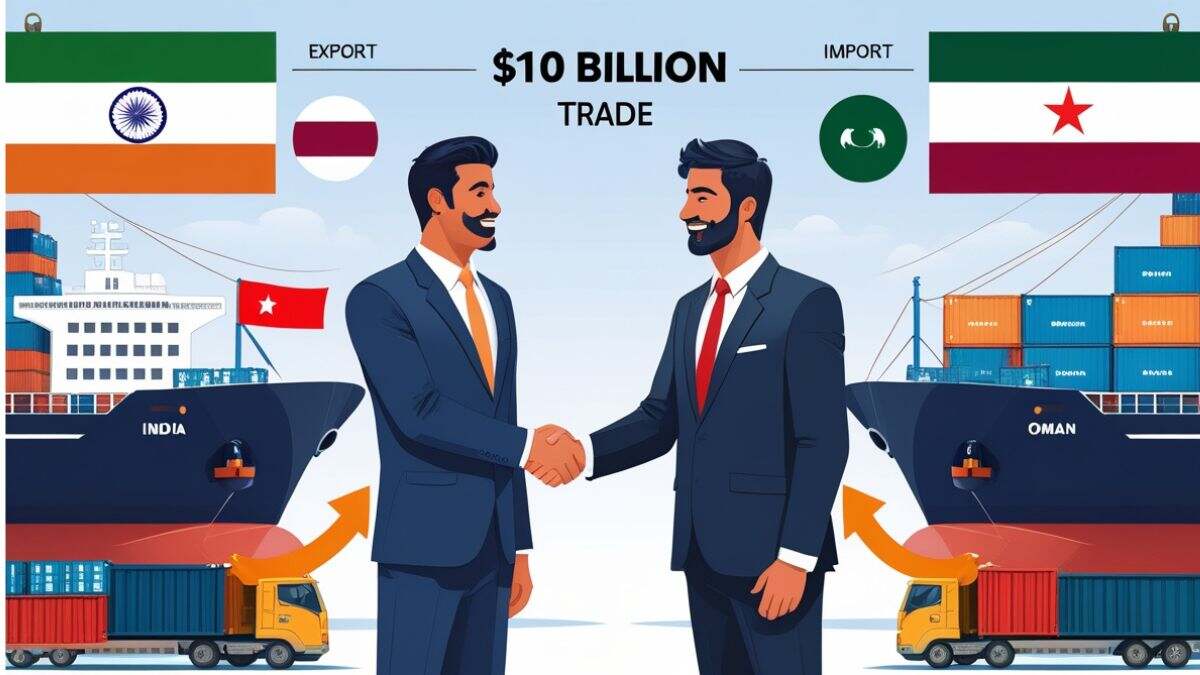The India-Oman Free Trade Agreement and other agreements with GCC countries might be crucial in diversifying Indian exports by lowering reliance on conventional clients in the face of higher US tariffs.
Following the United Arab Emirates (UAE), India is anticipating the announcement of a Free Trade Agreement (FTA) with Oman, its second agreement with a Gulf country. Moneycontrol describes the dynamics of bilateral commerce between Oman and India and the possible sectoral benefits of the free trade agreement.
Details of India-Oman’s $10 billion trade agreement
In 2024–2025, the total value of commerce between India and Oman was $10.61 billion, representing an 18.6% annual increase. India had a $2.48 billion trade imbalance in the previous fiscal year as a result of $6.55 billion in imports from Oman and $4.07 billion in exports to the Gulf country.
In the preceding fiscal year, India’s exports to Oman were relatively stable, with minor declines from $4.48 billion in FY23 and $4.43 billion in FY24. Meanwhile, imports increased by about 45% year over year as a result of a severe recession in 2023–2024.
Petroleum products accounted for $1.43 billion of Oman’s top exports in FY25, followed by engineering goods ($812.2 million), mica, coal, and other ores ($428.5 million), and chemicals ($241.4 million).
Additionally, the nation exports a small quantity of leather goods, textiles, jewelry, and jewels to Oman. These labor-intensive products that are suffering from higher US tariffs may see an increase in exports as a result of a trade agreement.
The FTA may also help India’s second-largest export to Oman, engineering items, whose exports to the US fell 5.1% in August over the previous month as the country began to experience the consequences of higher tariffs.
On average, Oman charges a 5 percent import tariff on almost 80 percent of Indian imports.
In addition to higher taxes on some meats, wines, and tobacco goods, Oman’s import duties vary from zero to 100 percent.
Fertilizers and mineral fuels account for the majority of India’s imports from Oman.
Mineral fuels and fertilizers accounted for $4.01 billion of India’s $6.55 billion imports from the Gulf States in FY25. Organic chemicals came in second with $608.74 million and plastics with $219.24 million.
India-Oman FTA schedule
In November 2023, negotiations for a free trade agreement between Oman and India were underway.
The proposed agreement, known as a Comprehensive Economic Partnership Agreement (CEPA), has been the subject of five rounds of in-person discussions between the parties, the most recent of which took place in New Delhi in January.
In August 2025, Jitin Prasada, the Minister of State for Commerce and Industry, notified the Rajya Sabha that the CEPA talks with Oman were over. Both Oman and India have said that the trade agreement would be announced as soon as September 2025, with Commerce Minister Piyush Goyal saying earlier this month that it may take place in a few weeks.
After India and the United Arab Emirates signed the Comprehensive Economic Partnership Agreement on February 18, 2022, which went into effect on May 1, 2022, efforts are on to negotiate a trade agreement with a second Gulf country. According to the commerce ministry, bilateral goods trade has almost quadrupled since the signing of the CEPA, rising from $43.3 billion in FY21 to $83.7 billion in 2023–2024.
In FY25, India and the UAE’s bilateral trade was $100.06 billion. But compared to exports, which climbed 2.84 percent for the year, imports grew 32.02 percent.
India’s labor-intensive exports, particularly in gem and jewelry, have increased by more than 60% from $4.95 billion in FY22 to $8.04 billion in FY24 thanks to the trade agreement with the United Arab Emirates. Therefore, in an effort to further diversify exports, New Delhi is aiming for $100 billion in bilateral non-oil and non-precious metal commerce with the UAE over the next three to four years.
With a contract with Oman imminent and the India-UAE free trade agreement as a model, the administration intends to establish similar agreements with other GCC countries, including Qatar.
The India-Oman Free Trade Agreement and other agreements with GCC countries might be crucial in diversifying Indian exports by lowering reliance on conventional clients in the face of higher US tariffs.

